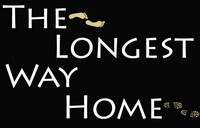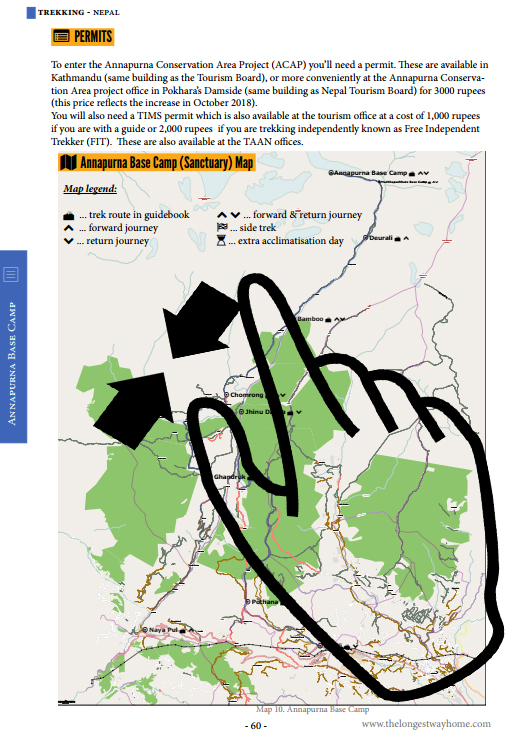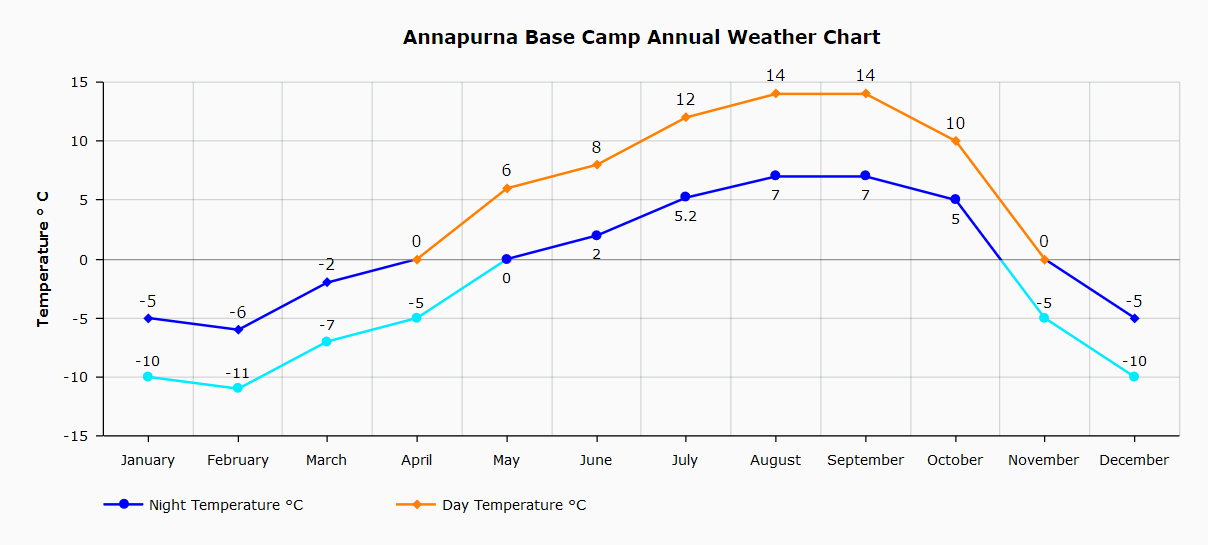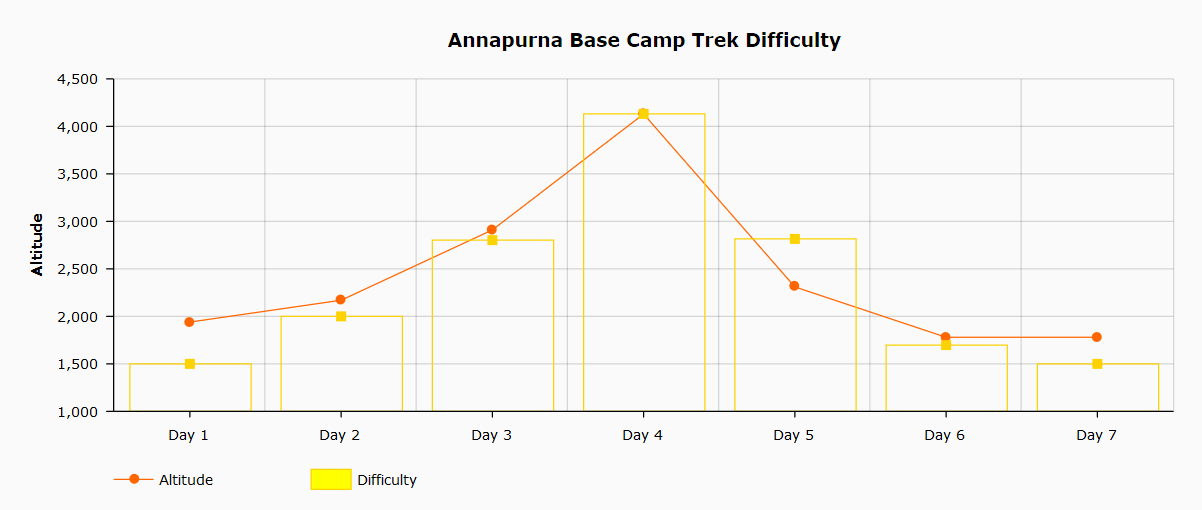About Annapurna Base Camp
The Annapurna Base Camp Trek (ABC) is also known as the Annapurna Sanctuary Trek and is one of the most popular short- to medium-length treks in Nepal. Altitude is rarely a problem on this trek, though there are still plenty of close-up mountain views.

Trekking route into Annapurna Base Camp
The trek itself is not particularly strenuous. Though being in good shape will, of course, help with the many steep steps that occur along the route. The first The first few days of the trek involve uphill trekking, which is the hardest part.
Passing through Gurung villages, lush forests and shrubs There's a diverse range of scenery to enjoy along the way. All of this culminates in the spectacular Annapurna Base Camp mountain views that surround you at base camp.
Here's my experience of the trek, plus the answers to many popular questions about the trek. A more detailed guide and maps are available in my trekking in Nepal guidebook.
Trek Overview
Difficulty: Moderate |
Days: 7-10 |
Max Altitude: 4,130 m |
Distance: 161 km (100 mi) |
Accommodation: Lodge |
Where is the Annapurna Base Camp trek?
Annapurna Base Camp (Sanctuary) is located in the Annapurna Conservation Area near Pokhara. It's just to the west of the Mardi Himal trek route. Or if looking at a popular map it's to the east of Poon Hill and Ghorepani.
The trek goes through quiet stone built villages, along mountain farms, forests and often has many flowers blooming en route. The first few days involve trekking uphill but after this the terrain flattens out and you can cover more
distance. There are plenty of steps to traverse but also plenty of rest stops. While acclimatization is not a
huge factor it's still important to keep an eye open for symptoms.
The Annapurna Base Camp treks main destinations include both Machhapuchhre Base Camp and Annapurna Base Camp. I've written up a full daily itinerary later on this page.
Map of the Annapurna Base Camp Trek
This map shows you the most popular Annapurna Base Camp trekking routes.
See on Google Maps - Get the Annapurna Base Camp GPX
Please note this map should not be used as a practical trekking map. While the main Annapurna Base Camp route remains the same there are variations depending on side trails, weather conditions, time of year, natural events and physical changes to the trek paths. No support is given for GPX files and they should only be used as rough trail routes. Do get my Trekking in Nepal guidebook for more detailed maps!
The above map is a sample from my Nepal guidebook - the only guidebook with trekking maps that can be zoomed right into - even for the smallest of trails!
Facts about the Annapurna Base Camp Trek
There's a lot of information about the Annapurna Base Camp Trek as it's one of the most popular treks with trekkers.
Highest point of the Annapurna Base Camp trek
4,130 meters (13, 549ft) is the highest point of the Annapurna Base Camp Trek and located at base camp itself.
Highest sleeping point on the Annapurna Base Camp trek
The highest sleeping point along the Annapurna Base Camp trek is at Annapurna Base Camp which is 4,130 meters (13, 549ft). Machhapuchhre base camp is 3,700 meters (12, 139ft).
How long have people been trekking to Annapurna Base Camp?

Annapurna Base Camp was first reached in 1956. The views have always been there though! The route has been popular with trekkers for nearly three decades. Over the past ten years the treks popularity has risen.
What mountains can you see from Annapurna Base Camp?
The Annapurna mountain range is on full show from various stages of the trek. Dhaulagiri, Annapurna I are often highlights and Manaslu. From base camp Annapurna I, Annapurna II, Annapurna III and Annapurna IV are also visible.
Highlights of the Annapurna Base Camp Trek
Highlights of the Annapurna Base Camp trek include:

- A relatively easy trek to see magnificent mountains
- Medium trek of only 8-10 days
- Good accommodation options
- Diverse menus
- Hot springs in Jhindu Danda
- Valley Trails
- Friendly locals
- Location intersects with other treks
How to arrange a trek to Annapurna Base Camp
Arranging a regular Annapurna Base Camp trek
There are many options here ranging from package tours to independent trekking. As per usual, booking online with private commercial companies can be significantly more expensive than package trips or booking in person when in Nepal.
Package tours bought online

Package tours bought online generally have a fixed itinerary with everything arranged for you. They don't allow for flexibility. e.g. If you want to spend more time trekking, if you do decide to extend your trek, you'll usually end up paying a lot more.
Package tours also (but not always) include food, porters, accommodation, and permits.
Pro's include that everything is done for you ahead of time.
Con's include that you don't know who your guide will be, and you'll be paying quite a bit more than getting everything done yourself. Guides often try to include Poon Hill on the trek.
Extended Annapurna Base Camp treks are quite popular, e.g., trekking to Poon Hill before embarking on the main trek. Here is a wide-ranging list of trekking tour operators in Nepal that can be booked online.
Package tours bought in Nepal
If you have a couple of days in Nepal then you can arrange a package trek along the Annapurna Base Camp route. Do shop around and don't get swayed by the typical talk of places names, mountain names or villages en route. Many will try to baffle you with mountain peak names and refer to the trek as the Annapurna Panorama trek or the popular Annapurna Sanctuary Trek - it's all the same thing!
What's important here is that you know what's included, meet your guide beforehand and feel comfortable with the agency/guide.
Do make sure that everyone knows what's included in the total price. Accommodation, permits, bus fees, meals etc. There are no flights involved with the ABC trek unless you are coming from Kathmandu to Pokhara (where the trek starts).
Quite often these package tours are broken up into different categories. High priced categories will included everything, while lower priced package tours might not include accommodation.
Pro's here include actually meeting the guide before hand, being able to ask questions in person and it's much cheaper than online.
Con's include listening to trekking agents talk up a huge amount about the trek that's mostly irrelevant. It's a sales technique in Nepal to make every trek sound technical and like you are about to see the world.
Again there are some local tour operators on my page with a list of trekking tours in Nepal.
Hiring an Annapurna Base Camp guide yourself
You might want to save on costs a little more and simply hire an independent local guide rather than a package tour. Again, the costs come down substantially however you'll be expected to do more.

You'll have to bargain and barter for your own room and order your own meals on the trek. This is something that's relatively easy along the Annapurna Base Camp route as most of the guest houses are all used to trekkers. However, the more friendly you are with the guide the more chance they'll help you out with this.
Pro's include a cheaper trek with more independence.
Con's include having to bargain and barter for your own rooms (it's not hard) and order your own meals (English menus, not hard). You'll also need to arrange things like permits which a good local guide can help you with. Just don't take advantage of their time. You can contact me if you'd like to have the details of the guide I used.
Independently trekking Annapurna Base Camp yourself
It is no longer possible to trek the Annapurna Base Camp by yourself. In March 2023 Nepal Tourism Board banned solo trekking in Nepal. You now need to hire a guide.
Get a fully qualified local trekking guide
If you are looking for a guide for the Annapurna Base Camp trek I recommend you read my article on How to hire a trekking guide in Nepal. Alternative use my Find a Trekking Guide Service.
You may also contact me if you wish to have my personal recommendation however it would be appreciated if you first purchase one of my guidebooks.
Best time of year to go trekking along the Annapurna Base Camp route
Weather along the Annapurna Route is always subject to change:
There are however peak seasons and the following months have traditionally been used as a guide for preferred times of the year to do the Annapurna Base Camp trek.
Annapurna Base Camp Weather by month
| Avg. Temperature (°C) |
Avg. Temperature (°F) |
Precipitation / Rainfall (mm) |
|
|---|---|---|---|
| January | -5 | 23 | 9 |
| February | -6 | 21.2 | 14 |
| March | -2 | 28.4 | 9 |
| April | 0 | 32 | 8 |
| May | 5.5 | 41.9 | 13 |
| June | 8 | 46.4 | 39 |
| July | 12 | 53.6 | 123 |
| August | 14 | 57.2 | 136 |
| September | 14 | 57.2 | 62 |
| October | 10 | 50 | 6 |
| November | 0 | 32 | 0 |
| December | -5 | 23 | 5 |
Do note that altitude and mountainous terrain play a strong factor in the comparative weather temperatures. In the winter months expect at least -10 degree lower night time conditions in the higher parts of Annapurna Base Camp. See the chart below for average lows.
Annapurna Base Camp Annual Temperature Index Chart
Clouds play a part in any trek. Taking a look a precipitation index and you'll see when clouds cover most of Annapurna Base Camp (July/August). However do note the temperature drops in Annapurna Base Camp along with precipitation which means there's a strong chance of snow.
Important
Since February 2019 to 2025 during the months of February and March Annapurna Base Camp has experienced heavy snow. This has damaged rooftops of teahouses and closed them. Avalanches have occured. And deaths have occured. If snow is falling then there's a strong chance passes from MBC to ABC will be blocked. The route is often closed at this time due to safety concerns. Unfortunately there is no accurate weather prediction in that region and snow warnings often happen with only a days nottice. As such it is not recommended to trek the Annapurna Base Camp during the winter months leading up to mid-March.
Months with the best weather to trek Annapurna Base Camp
Mid Sept-October - November/(early)December: this is Nepal's peak and best time to go trekking.
February-March-April: this is the end of the dry season and the second best time of year to go trekking however do be aware of snowfall at base camp. It is not recommend to trek ABC until mid-March has passed and all snowfall has finished.
November/December to January/February: the skies are clear but it can get very cold and there is a risk of passes being closed due to snow.
May - June: This is Nepal's hot pre-monsoon season and it can get very warm indeed. The valleys however are starting to bloom with flowers though.
June - Mid September: this is Monsoon season and the least popular time to go trekking in Nepal.
For more details please see my guide on the best time of year to go trekking in Nepal
What permits do I need for Annapurna Base Camp?
If you are on a package trek or tour to Annapurna Base Camp then your guide or trekking agency will and should take care of all your permits for you. For independent trekkers you'll need to do it yourself. In all cases here's what permits you need and how to get them for the Annapurna Base Camp trek.
You need two permits for the Annapurna Base Camp Trek
- Annapurna Conservation Area Project Permit (ACAP)
- Trekker Information Management System (TIMS Card)
Both or these permits can be bought in either Pokhara or Kathmandu at the Tourist Information Center. As Pokhara is far closer to the start of the trek then the Pokhara office is a better and quieter choice by far. Both offices are open between 10am - 5pm however it is better to arrive an hour or so before closing time. In Pokhara getting the permits only takes about 30 minutes if you have everything you need.
Get the Annapurna Conservation Area Project Permit (ACAP)
An Annapurna Conservation Area (ACAP) covers all of the Annapurna National Park.

The permit is only valid for one entry and one exit. However, so long as you don't exit, you can use it for as many treks as you want including the
Annapurna Base Camp Trek.
You can also get one online via an
e-permit
https://epermit.ntnc.org.np
(additional surcharge applicable) or via your trekking agency (cheapest and easiest).
Guides can do
this before you arrive.
It is a mandatory permit.It is a mandatory permit.
- Fill out the ACAP form
- Hand over the completed form, your passport and 2 passport photos ( do note the office taking photos for free at the moment)
- Pay the 3,000 rupees (only payable in Nepali Rupees)
- Get your ACAP permit
Get the Trekker Information Management System Card (TIMS)
The Trekkers Information Management System Card (TIMS) is meant help protect trekkers through registration checkpoints along a trek including Annapurna Base Camp. The fees also go towards guide and porter insurance.

Do note that the TIMS Card is now a flat 2,000 rupees
and a trekking company is the only one that can apply for it.Both the ACAP and TIMS card can be used for all applicable treks until they receive an exit stamp. Once either permit have an exit stamp they cannot be used again. Do be careful about this if combining Annapurna Base Camp with another trek. If you get exit stamps and try to enter/leave again there is a hefty 6,000 rupee on the spot fine! The nearest trek is Poon Hill and you don't need separate permits if you wish to visit the area.
Permit check points for the Annapurna Base Camp trek include Birethanti and Chomrong.
2025/2026 Extra permits on the way? In early 2025 Annapurna Rural Municipality began work on additional toilets and drinking water stations on the trek. They also made mention of a new checkpoint. There is a strong possibility that following other trekking regions, ABC may soon introduce a new rural municipality permit to cover these costs. If they do, it will be updated here once it is established.
What equipment do I need to take on the Annapurna Base Camp trek?
If you are on a package tour then your agency will give you a list of things to bring for your trek.
Otherwise if you are trekking on the Annapurna Base Camp in Nepal you'll need the following:
Depending on the time of year you'll need to make adjustments to clothing and equipment (do see the weather charts above). The following equipment list for the trek will help:

- A worn in pair of hiking boots
- A wind cheater style of jacket
- Long sleeve shirts
- Fleece
- Trekking pants
- Shorts
- Socks
- Rubber sandals
- Map
- Sunscreen
- Lip balm
- Sunglasses
- Heat / leak proof water bottles
- Water purification system
- Sleeping bag during peak and cold seasons
- Trekking poles (due to the amount of steps on this trek)
ABC has run short on blankets in the past during peak season. It's advisable to bring your own sleeping bag then and during peak seasons.
Please note the above is a very basic list. For a full comprehensive list please see my article on trekking equipment you need for Nepal
How difficult is the Annapurna Base Camp Trek?
Download my guidebook and get the full details of this trek
It's only $4.99 USD to download this trek now in the First Time Trekking in Nepal guidebook
Or get this trek plus 28 others in a premium guidebook for only $19.99
Also available in paperback
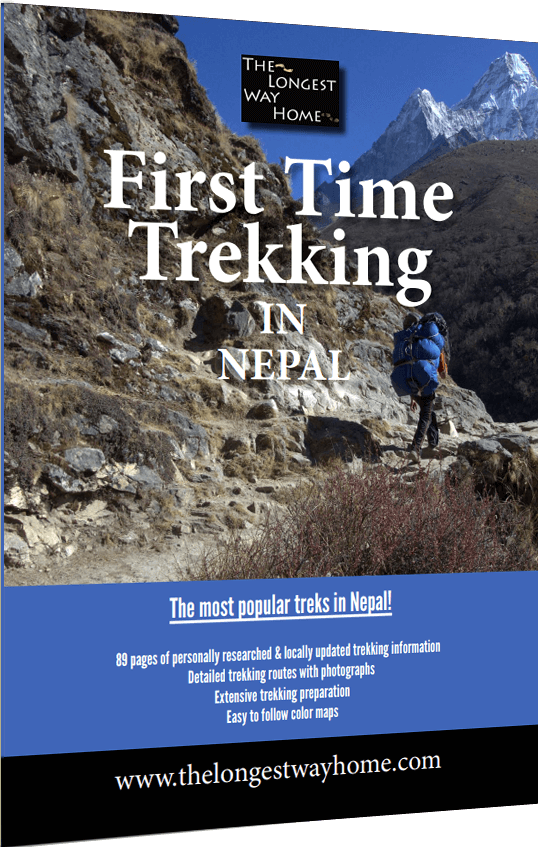
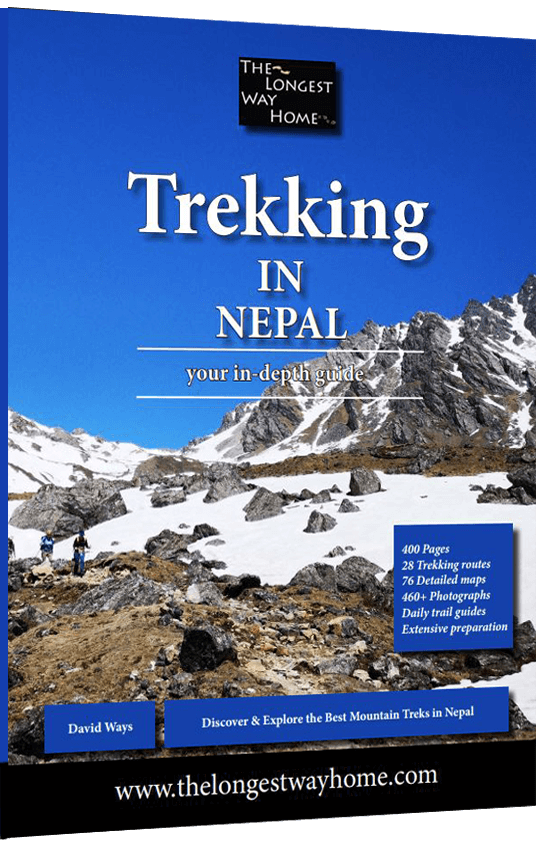
or
Get the Trekking in Nepal Guidebook $19.99Annapurna Base Camp is known as a moderate trek. It's short but there is some altitude involved along with some cold conditions.
In terms of terrain and the trails there are no ropes needed and no ice picks needed. There is no vertical climbing involved.
The trails are not paved aside from the village areas in some locations. It is rough, rocky and gravel strewn. There are plenty of stone steps to traverse on this trail so trekking poles can be of great help to help protect your knees on the way down.
While the ABC trek can be shortened to 8 days there are issues with altitude sickness and fitness which needs to be considered. Below is a look at the difficult days on the safer 10 day trek.
Day 1 A relatively easy day and a nice lead into the days ahead.
Day 2 Picks things up a little with a solid hour of steps
Day 3 Surprising many there's a lot of down hill and steps here along with ups
Day 4 A long hard day culminating in a relatively easy trek from MBC to ABC!
Day 5 A steep decline in altitude but it's not all downhill with a lot steps to cover
Day 6 One of the easier days but complied by the two previous days
Day 7 The last day is one of the easiest with little altitude change.
Again it's quite feasible to extend the ABC trek up a day or two. Many people prefer to spend the night in Machhapuchhre Base (MBC) Camp and visit Annapurna Base Camp (ABC) the next morning for sunrise.
How fit do I need to be to go on a Annapurna Base Camp Trek?
A certain level of fitness is required however there is no direct climbing involved on this trek. You will need to trek over some rocky areas near Machhapuchhre base camp and base camp itself.
There are also a considerable amount of stone steps to climb and descend on the ABC trek. Going up is usually okay. But coming down can really put a strain on ones knees. Trekking poles can help here immensely.
I would advise anyone going trekking to see a doctor before they go for a check-up and to talk about dealing with altitude sickness.
For pure trekking alone the Annapurna Base Camp in Nepal you'll need to consider the amount of days you'll be out trekking to get an idea of how fit you should be. Most days include 4-6 hours of slow hiking. Keep in mind the entire Annapurna Base Camp trek is about 8-10 days covering roughly 161 km plus about 20 km of bus travel on that way there.
The hardest point for many people is going from Himalaya to ABC as it's a long day.

The whole trek as a whole does not have that many steep parts and offers a gradual ascent.
Altitude sickness is not really a problem on the ABC trek as you won't be at a high altitude for very long. As a precaution do read about altitude sickness in Nepal.
As with most treks, generally speaking, the slower you trek, the easier it is so adding a day to the 8 day itinerary is a good idea.
What's the food like on the ABC trek?
The food is typical Nepali trekking food. Meaning you can get just about anything for a price with a good range of offerings compared to other trekking routes. Dal Bhat is the staple followed by pasta, pancakes and chop suey. It won't be Michelin star quality food, but it will get the job done.

This is a plate of typical Dal Bhat on the Annapurna Base Camp trek - rice, lentils, potato curry, fresh vegetables and soup
Do keep in mind that you will be burning a lot of calories and you will need to drink a lot more water. Trekking staples like Dal Bhat are filling, healthy and filled with good calories to keep you fueled up. This is what Dal Bhat looks like when you are out trekking.
Beer, soda, coffee, tea, hot lemon and water are also widely available. But just like food the price goes up the further you get to Base Camp.
Typical Annapurna Base Camp Menu
| Item | Price |
|---|---|
| Porridge with milk | 300-350 Rupees |
| Fried eggs (2) | 250-300 Rupees |
| Cheese Omelet | 400-450 Rupees |
| Tibetan Bread | 350-400 Rupees |
| Dal Bhat (Meat) | 500-1000 Rupees |
| Dal Bhat (Veg) | 400-700 Rupees |
| Boiled Potatoes | 300-350 Rupees |
| Fried Noodles (Veg) | 300-400 Rupees |
| Fried Potatoes with Cheese | 450-550 Rupees |
| Macaroni with cheese | 400-500 Rupees |
| Tea/Coffee | 50/100Rupees |
| 1 liter beer | 600+ Rupees |
| Soft Drinks (Coke, Sprite etc.) | 120-150 Rupees | 1 liter tap water (from underground spring or stream) | free |
| 1 liter boiled water (for filtering) | 50 Rupees | 1 liter bottled water (if available)* | 100-150 rupees |
Water sold in bottles is hard to find. In 2015 several NGOs banded together and encourage ACAP to ban plastic water bottles. Unfortunately the ban did not cover soft drinks and other plastics which now outnumber water bottle pollution. The second result is that there are now several old water filtration systems in many teahouses. It's highly advisable you perform your own water treatment even on this water as they may not be cleaned regularly. Teahouse filtered water costs about the same and is not boiled.

Bowl of egg noodle soup on the Annapurna Base Camp Trek (egg, veg or meat is added)
Treats like chocolate bars can be bought all along the ABC trek route. Bring a block of Yak cheese which can really help with adding protein to your diet. Or carry some candy bars for some treats.
What's accommodation like on the Annapurna Base Camp trek?
Accommodation in the ABC region is plentiful and there's usually a good choice in each little village you come to.

Tea Houses filling up is only a problem during peak season but a good guide will book ahead for you. A sleeping bag is useful on this trek as they always seem to be running short of extra blankets. I didn't have a problem with any of the accommodation but I would advise to bring some ear plugs in case you have a noisy neighbor as the room walls are all cheap plywood Some baby wipes for the bathroom are always handy.
Running hot water is not available in every village though hot showers are available. Buckets of hot water are also available. .
During the winter months fires are commonplace including fires for under your table on the coldest of nights.
List of hotels & teahouse telephone numbers in Annapurna Base Camp
| Tea House Name | Telephone Number |
Location |
|---|---|---|
| Annapurna Guest House | +977-9848427448 | Ghandruk |
| Snowland | +977-846209264 | Ghandruk |
| Excellent View Top | +977-9856020909 | Chhomrong |
| Fishtail Lodge | +977-9867680082 | Chhomrong |
| Himalayan | +977-9746027283 | Himalaya |
| Himalaya | +977-9756000208 | Himalaya |
| Shanker | +977-9846293225 | Machhapuchhre Base Camp (MBC) |
| Fishtail Lodge | +977-9746089377 | Machhapuchhre Base Camp (MBC) |
| Annapurna Sanctuary Lodge | +977-994610000 | Annapurna Base Camp |
| Hotel Snow Land Lodge | +977-994-610002 | Annapurna Base Camp |
| Bamboo Guest House | +977-9846290080 | Bamboo |
| Bamboo Lodge | +977-9846257488 | Bamboo |
| Evergreen | +977-9476007049 | Jhinu Danda |
| Jhinu Guest House | +977-9846211474 | Jhinu Danda |
To help you, here is what trekking accommodation looks like in Nepal.
How much does the Annapurna Base Camp trek cost?
Costing for the Annapurna Base Camp trek is subject to many things. Package tours bought overseas from private companies are the most expensive. Package trekking tours from international online booking outfits is next. Going with just a guide is next. And finally going it alone is the cheapest.

Online tours of between 8-10 days can cost up to USD$1,000+ pp. Not including water. This does include a guide, accommodation, permits and meals. Personally speaking, I don't think these are good value.
Pro's include having your trek arranged before you arrive.
Con's include extra cost, a fixed itinerary, hidden extras.
Package tours bought from online brokers for 8-10 days these can cost $600-1100+. This includes a guide, permits, meals and accommodation.
Pro's include having everything arranged for you. Booking through a well known 3rd party.
Con's include fixed itineraries, not meeting your guide and extra cost.
See my list of trekking tour prices.
Package tours bought in Nepal for 7-10 days these can cost $450-900+. This includes a guide, permits, meals and accommodation.
Pro's include having everything arranged for you. Dealing one on one with an agency and meeting the guide beforehand. Much lower risk of accommodation booking out as everything is booked ahead (over booking happens on the ABC trek)
Con's include sending time going from trekking agency to agency getting prices yourself. Listening to trekking companies trying to sell you extra days.
If you are looking for a package trek for Annapurna Base Camp trek then I recommend you use my Find a Trekking Guide Service.
Guide only services can cost from $26 to $50 per day. The more you pay, the more experience your guide should have and the more you should benefit from the trek e.g., learn more about the surroundings etc..
Two or more people traveling together can make things cheaper. You are essentially halving the cost of guide and accommodation. Something to consider if budget is an issue.
Pro's include meeting the guide you'll be trekking with before the trek. The feeling of saving some money.
Con's include spending time finding the right guide. Not being sure they are an official guide. The savings are minimal compared in county packages.
If you are looking for a package trek for Annapurna Base Camp trek then I recommend you read my article on how to find a trekking guide in Nepal. Alternative use my Find a Trekking Guide Service.
Going alone will certainly save you money. It's a relatively well marked trail. However during peak season rooms do get booked out quickly. There are plenty of tales involving independent trekkers having to move back down a village as high camp has been booked out or sleeping in the common room. If you've not trekked alone before in Nepal then it's advisable your first trek should be with a guide.
Pro's here include the savings of not taking a guide.
Con's include having to get your own permits, transport and the possibility of not having a bed for a night during peak season.
Average 7 day trek cost to Annapurna Base Camp
| Item | Cost USD $ |
| Permits (ACAP, TIMS) | 40 |
| Guide x 7 days | 175 |
| Accommodation x 7 (private) | 28 |
| Meals 3x5 | 105 |
| Water 4 liters a day (filtered & boiled) | 28 |
| Transport (private-RTN) | 15 |
| Total | 391 |
Extras: Don't forget to include a tip for your guide 10%. Any soft drinks, sweets, hot drinks etc. you may want to purchase along the way.
Annapurna Base Camp trek is generally more expensive in terms of accommodation and food than the Annapurna Circuit Trek.
- The cost of an average teahouse with shared bathroom is 300 rupees in the off season and 350-500 in peak.
- The cost of one liter of filtered water reaches a maximum of 70 rupees at high camp. It starts at around 50 rupees.
- The cost of a plate of Dal Bhat starts at around 450 rupees and climbs to 800+ rupees.
- A popular chocolate bar can cost 200 rupees.
Many people with trekking experience will consider a guide/porter as they are cheaper. It should be noted these are trainee guides and may not have a lot of English.
Don't forget to include your travel insurance in your budget. And be aware that many policies don't include trekking above 4000 meters. Here is my recommendation for travel insurance when in Nepal.
Annapurna Base Camp trekking itinerary & route
Download my guidebook and get the full details of this trek
It's only $4.99 USD to download this trek now in the First Time Trekking in Nepal guidebook
Or get this trek plus 28 others in a premium guidebook for only $19.99
Also available in paperback


or
Get the Trekking in Nepal Guidebook $19.99Due to the ABC treks relatively fixed location there is basically only one way in or out. However there are many options to start the trek e.g., after the Annapurna Circuit, after Poon Hill or just by itself.
Here is a typical Annapurna Base Camp 7 day itinerary
| Day | Route | Distance (time) | Highest Altitude |
| 1 | Pokhara - Naya Pul to Ghandruk | (bus or car/trek) 1hr/5-6hrs avg | 1,940 m |
| 2 | Ghandruk to Chomrong | 4-5hrs avg | 2,170 m |
| 3 | Chomrong to Himalaya | 5-6hrs | 2,910 m |
| 4 | Himalaya to Machhapuchhre Base (MBC) Camp/Annapurna Base Camp (ABC) | 5-6hrs | 4,130 m |
| 5 | Annapurna Base Camp to Bamboo | 6-7hrs | 2,310m |
| 6 | Bamboo to Jhindu Danda | 5hrs | 1,780m |
| 7 | Jhindu Danda to Naya Pul - Pokhara | 6hrs + 1hr drive | 1,780m |
Here is a typical Annapurna Base Camp 10 day itinerary
| Day | Route | Distance (time) | Highest Altitude |
| 1 | Pokhara - Naya Pul to Ghandruk | (bus/trek) 5-6hrs avg | 2,000m |
| 2 | Ghandruk to Chomrong | 4-5hrs avg | 2,210 m |
| 3 | Chomrong to Bamboo | 4-5hrs | 2,310m |
| 4 | Bamboo to Deurali | 5-6hrs | 3,200m |
| 5 | Deurali to Machhapuchhre Base (MBC) Camp/Annapurna Base Camp (ABC) * | 2 hours avg | 3,700m |
| 6 | Machhapuchhre Base Camp/Annapurna Base Camp* | 2hrs | 4,130m |
| 7 | Annapurna Base Camp to Bamboo | 6-7hrs | 2,310m |
| 8 | Bamboo to Jhindu Danda | 5hrs | 1,780m |
| 9 | Jhindu Danda to Potana | 5hrs | 1,780m |
| 10 | Potana to Phedi | 20 km (bus/trek) (5hrs/ 2-4hours) | 1,600m |
Read more at: https://www.thelongestwayhome.com/travel-resources/trekking/annapurna-base-camp-sanctuary-trek-information.html
Copyright © www.thelongestwayhome.com
Instead of copying please consider buying one of my travel guides to Nepal. They are great value. Have much more content. Are easy to read and most importantly they help support my website and the original content that I write. Thank you!
* These are days that people often cut back on if stuck for time - thereby reducing it to a 9 day trek. As per the 7 day itinerary you could also cut back by going straight from ABC to Jhindu Danda.
Generally speaking if you are fit and have limited time the 7 day itinerary is good. If you are going in the first spring season then keep an extra day in reserve in case of cloud coverage. If you have bad knees or are not so fit then the 10 day itinerary to Annapurna Base Camp is far more enjoyable.
There are many villages and tea houses along the Annapurna Base Camp trek. You can easily stay in any of them depending on how you are feeling. Depending on your guide you may stop for the night in different villages than the ones mentioned in this itinerary. This is normal and nothing to be alarmed about. The above itinerary is the preferred route by many due to the scenery you'll encounter. It is also featured in great detail in my guidebook on trekking in Nepal.
More information on Trekking in Nepal
Annapurna Base Camp (ABC) is just one of many treks in Nepal. For alternative treks do read my list of treks in Nepal which is continually being added too based on popularity or request.
If you are looking for a trekking guide I recommend you read my article on How to find a trekking guide in Nepal.
You may also contact me if you wish to have my personal recommendation however they are all listed in my guidebook to Nepal which is a lot faster way of getting a guides details. If you want to book online check my list of trekking tours to Nepal.
On the following pages below I've compiled detailed articles on the specifics of trekking in Nepal that may be of use to you.
You will find them to be a great place to research your whole trekking trip to Nepal - be sure to bookmark them for future reference!
Finally, for a completely detailed day by day guide on the APC trek with photos plus much more do check out my guidebook below.
These guidebooks are a hands on trekking guidebooks that are better than the rest. Yes, really!
The books contain day-by-day guides with accuracy using scalable maps, photographs and travel-tested up-to-date trekking information. Just like my other guidebooks these have been proven to be the best interactive, or paperback guidebooks to Nepal available anywhere today.
So what are you waiting for? Get your hands on these guidebooks and start trekking in Nepal today!
 |
 |
First Time Trekking in Nepal
|
Trekking in Nepal
|
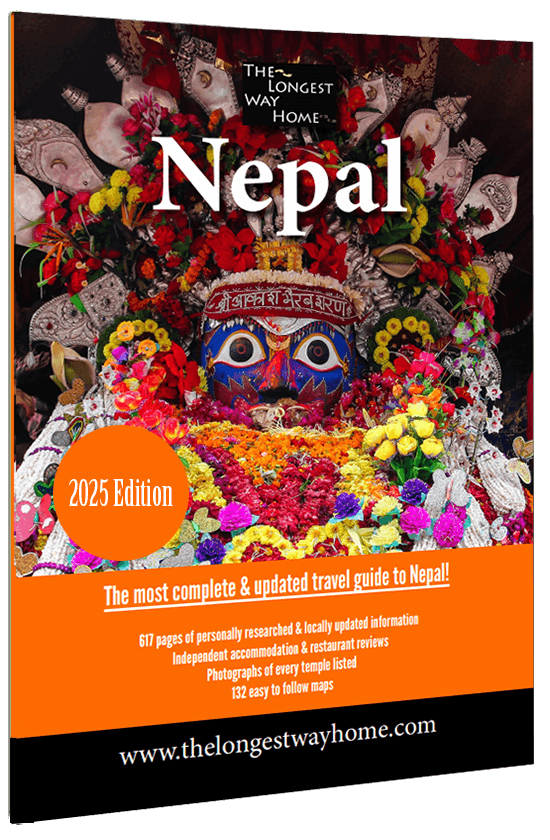 |
|
| Full Nepal Guidebook Complete country guide that also includes First Time Trekking in Nepal |
|
Was this page helpful to you? If so please tell others!

